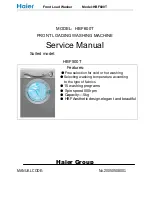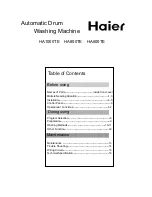
517792A
16
2.7.3
Rotor Position Sensor (RPS)
One of the inputs that the Motor Control Module needs in order to determine which switches to turn
on is the position of the rotor. The rotor position sensor (RPS) supplies this information.
The RPS is a printed circuit board that contains
three Hall Sensors. These detect the magnetic
field of the individual magnets in the rotor. As
the motor turns, the position of a group of
magnets is detected. There are 5 wires on the
RPS, 2 for power supply and 3 signal wires.
Data on the position of the rotor is supplied to
the microprocessor in the Motor Control Module
via the three signal wires.
The printed circuit board sits in a plastic housing
encapsulated by resin to protect the board. The
only exposed area of the board is the connector
for the main harness.
2.7.3.1
Testing the Rotor Position Sensor
To test the RPS use a RPS tester, part number 502105, which is powered by a 9V battery. To test
the RPS of a Phase 7 Washer it will also require an adaptor harness, part number 420892. The
tester has 3 LEDs, and the pattern of these LEDs will change as the magnetic field of the Rotor
passes the hall sensors.
Connect the RPS tester to the RPS harness. Turn the basket and note the pattern of lights. A
valid pattern is a pass. A fail will indicate a failure of either the harness or the RPS. If a failed
pattern is showing, connect the RPS tester directly on to the RPS and retest.
A pass is when 1 or 2 LEDs are illuminated at a
time, 0 or 3 LEDs illuminated indicates fail. Any
flickering of the fail LED will indicate that the
RPS or rotor is faulty. A faulty rotor would give
a fail at certain points of rotation.
Note: This tester does not test all the functionality of the RPS. It tests the 3 outputs but
cannot indicate all faults, for example if a capacitor on the RPS is cracked.
The rotor may also be tested with a RPS Tester. A complete rotation will test all the magnets.
If the rotor has cracked or chipped magnets it will work fine, and does not need to be replaced.
















































